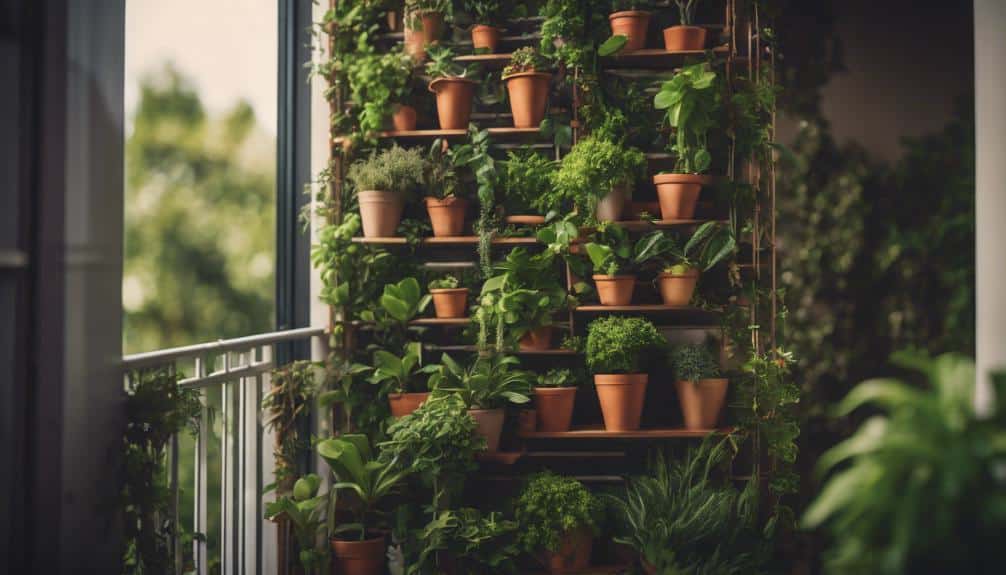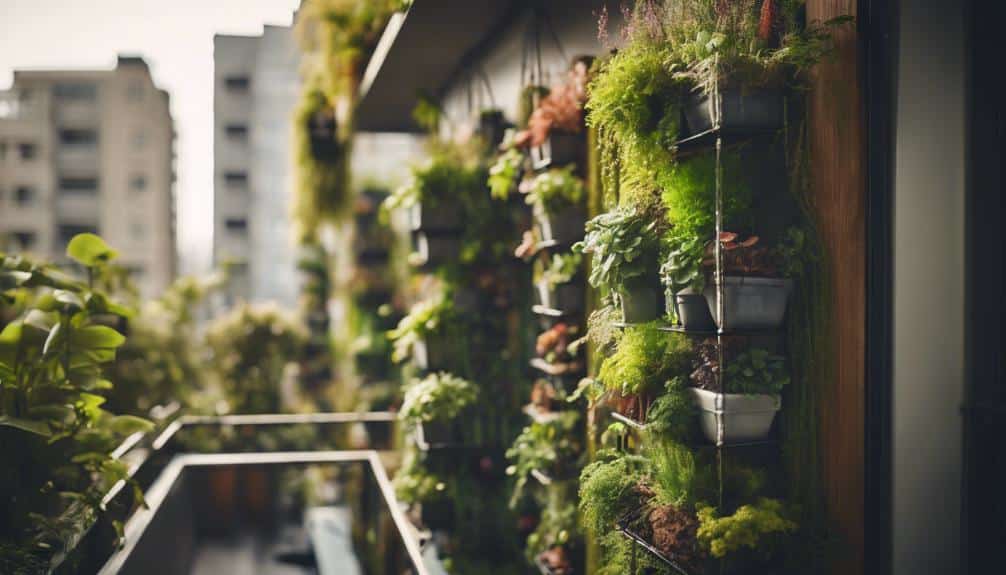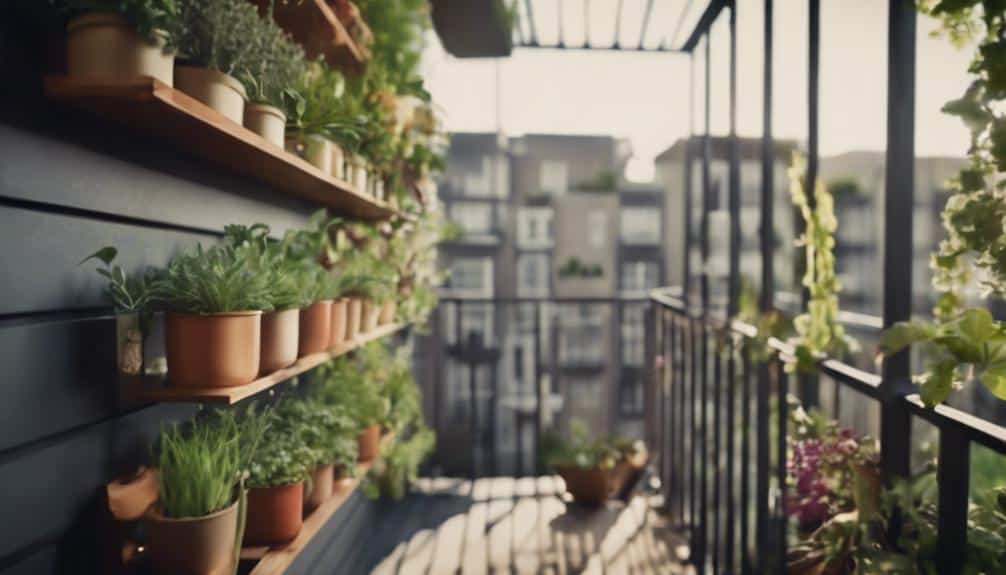Start vertical gardening in small spaces with trellises, stakes, hanging baskets, and vertical planters. Use shallow-rooted greens like lettuce and herbs, vining crops such as tomatoes and beans, and trailing foliage plants. Maximize floor space by training plants upwards on these structures.
Adapt watering frequency to plant needs and consider drip irrigation for convenience. Use a lightweight, moisture-retentive soil mix for healthy growth. With proper care, your vertical garden will flourish in even the tiniest spaces.
If you have small space for gardening container gardenening on the balcony is also a good idea. And there are some vegetables only requre small space to grow.
What structures can be used for vertical gardening?

Several structures like trellises, stakes, and hanging baskets can elevate your gardening game by allowing plants to grow upwards, saving valuable space.
You can create your own DIY trellis designs with just a few materials like bamboo sticks or old wooden ladders, which not only support your climbing plants but also add a unique aesthetic to your garden.
Consider utilizing vertical planters for herbs or small vegetables; these can be mounted on walls or fences, optimizing your gardening area.
Additionally, integrating garden wall art with climbing vines can transform a bland wall into a lively green space. These approaches not only enhance the beauty of your garden but also make efficient use of limited spaces.
Which plants are suitable for vertical growing?
Now that you’re familiar with the structures that can support your vertical garden, let’s look at which plants will thrive in this unique growing environment. Your vertical plant selection should include:
- Shallow-rooted greens like lettuce and herbs
- Vining crops such as tomatoes and beans
- Trailing foliage plants, including philodendrons and spider plants
- Air plants for minimal soil requirements
- Orchids for their vertical beauty
When choosing plants, consider their sunlight, water, and nutrient needs to make sure they’re a good fit for your vertical garden.
Proper growing techniques and maintenance tips are key to maximizing your garden space efficiently while keeping your plants healthy and beautiful.
This approach not only enhances the aesthetics of your space but also allows you to enjoy fresh produce right from your vertical garden.
How do you maximize limited floor space?

When you’re working with limited floor space, it’s crucial to think creatively about how you can grow more in less area.
By selecting the right plants and leveraging vertical structures, you can effectively use every inch of your available space.
Training plants upwards and creating living walls not only maximizes your gardening area but also enhances light exposure, ensuring your plants thrive.
Consider Plant Choices
To maximize your limited floor space, you’ll need to carefully select plants that can flourish under your specific light and space conditions. Choosing the right plants involves understanding their:
- Plant maintenance, including watering frequency
- Soil composition and nutrient requirements
- Plant placement and spacing guidelines
Opt for hardy plants that thrive in limited sunlight, like fuchsia, hardy geraniums, and ferns.
Herbs such as mint, parsley, and chives are also great choices due to their adaptability and minimal space requirements.
These selections not only guarantee your vertical garden is lush and vibrant but also manageable with care and growth.
Utilize Vertical Structures
Maximizing your garden’s vertical space involves creatively employing structures like trellises, arbors, and hanging baskets to support and elevate your plants.
By integrating these elements, you’re not just making the most out of limited floor space but also crafting creative displays that breathe life into small areas.
Think of vertical design as your best ally in the quest for space-saving solutions. Utilize pergolas, planter boxes, containers, shelves, pouches, or even fences as the backbone of your vertical garden.
These structures don’t just serve as support for climbing plants; they transform plain walls and unused spaces into lush, green canvases.
Train Plants Upwards
Training your plants to grow upwards on trellises, arbors, or other structures is a smart way to fit more greenery into a limited space.
By employing vertical training, you’re not only saving floor space but also encouraging healthy upward growth which supports stronger plant development.
Here’s how to maximize your small garden area:
- Choose the right structure: Select trellises or arbors that suit your plant’s growth habit.
- Implement trellis techniques: Use ties or plant clips for secure attachment.
- Optimize for light: Position your structures to guarantee plants receive adequate sunlight.
- Regular pruning: Keep your plants tidy and focused on upward growth.
- Monitor and adjust: Be prepared to provide additional support as your plants grow.
These steps, rooted in maximizing yield through vertical training, transform your limited space into a lush, upward garden.
Create Living Walls
Creating living walls is a vital approach to utilizing vertical space and turning bare walls into vibrant displays of greenery. You can maximize limited floor space by exploring creative mounting options that allow plants to thrive vertically.
Consider the indoor vs. outdoor suitability of your chosen plants to make sure they flourish. For indoor settings, select species that thrive in lower light and humidity levels, while outdoor walls can accommodate a wider range of plants.
Maintenance tips are essential for the success of your living wall. Regular watering, ensuring adequate drainage, and periodic fertilization will keep your green oasis vibrant.
Enhance Light Exposure
To guarantee your plants thrive, position them where they’ll receive ample sunlight throughout the day, a critical step in optimizing limited floor space.
When sunlight is scarce, consider these strategies:
- Use artificial lighting solutions, such as LED grow lights, to supplement natural light.
- Install light reflecting surfaces behind or beneath plants to diffuse light more evenly.
- Schedule your plants’ sunlight exposure timing, ensuring they receive direct light when it’s strongest.
- Place taller plants towards the back and shorter ones in front to prevent shading.
- Rotate your plants regularly to make sure all sides receive equal light exposure.
These methods help maximize light exposure, ensuring your vertical garden flourishes even in the smallest spaces.
Improve Air Circulation
Beyond enhancing light exposure, improving air circulation around your vertical garden greatly reduces the chances of plant diseases.
Maximizing air circulation benefits isn’t just about keeping your plants healthy; it’s also important for pests prevention and mold reduction.
By employing vertical gardening, you’re not only making the most of your limited floor space but also guaranteeing that air can freely move around each plant.
This setup notably lowers the risk of mold and mildew, which thrive in stagnant air conditions. Additionally, better air flow makes it harder for pests to settle and infest your plants.
To optimize these benefits, make sure there’s enough space between your vertical planters and regularly check for any signs of overcrowding.
What are the watering needs for vertical gardens?
Understanding the watering needs of your vertical garden is essential for its thriving, as these requirements vary depending on the type of plants you’ve chosen, their exposure to sunlight, and the volume of soil they’re growing in.
Here are key points to keep in mind:
- Watering frequency varies by plant selection; leafy greens may need daily attention.
- Consider sun exposure and moisture retention; more sun means more water.
- Use drainage solutions to prevent waterlogging.
- Employ watering techniques like drip irrigation for consistency.
- Fruit-bearing plants like tomatoes demand more frequent watering, around 1/4 inch daily.
Are there any special soil requirements?

After attending to watering needs, it’s essential to contemplate the soil requirements for your vertical garden to guarantee plant health and growth.
You’ll need a lightweight, moisture-retentive mix that’s adept at both nutrient retention and drainage solutions.
Incorporating materials like clay or bentonite helps with water and nutrient retention, while pine bark, peat, and perlite enhance the soil composition, catering to both watering requirements and root zone management.
Don’t forget to mix in fertilizers for added nutrients and consider water crystals for container gardens to maintain moisture levels.
Ensuring proper drainage while providing sufficient moisture and nutrients, especially in the top 6-inch root zone, is key for a thriving vertical garden.
How much sunlight is needed for vertical gardens?
To guarantee your vertical garden thrives, it’s crucial to provide the right amount of sunlight, typically ranging from 6 to 8 hours of full sun daily, depending on the plant variety.
When planning your garden, consider the sunlight requirements and plant selection carefully. Here are some tips to help:
- Vines and climbing plants: Need 6-8 hours of sun.
- Herbs and small vegetables: Also require 6-8 hours.
- Succulents and cacti: Thrive with 6-8 hours.
- Tomatoes, peppers, cucumbers: Demand 6-8 hours.
- Basil, parsley, other herbs: Require some direct sunlight.
Utilizing vertical structures not only maximizes space but also allows for efficient sunlight distribution.
Training plants on living walls can make sure they receive the necessary sunlight, fulfilling their growth potential.
Frequently Asked Questions
Can Vertical Gardens Help Improve Air Quality Indoors?
Yes, vertical gardens can improve your indoor air quality through the right plant selection, offering filtration benefits that clean the air. You’ll need to follow some maintenance tips to keep your garden thriving and effective.
How Often Should Vertical Garden Structures Be Replaced?
You should replace your vertical garden structures based on their maintenance schedule, material durability, and any design updates. This guarantees your garden remains functional and attractive, without explicitly tying it to indoor air quality improvements.
Are Vertical Gardens Pet-Friendly?
You’re wondering if vertical gardens are pet-friendly. It’s important to implement pet safety measures, identify toxic plants, and opt for non-toxic alternatives to make sure your furry friends stay safe while you enjoy your green space.
Can You Grow Edible Plants Vertically in Winter?
yes, you can grow edible plants vertically in winter by using winter insulation strategies, indoor lighting options, and cold-resistant varieties. These techniques guarantee your vertical garden thrives even in the colder months.
What Pests Commonly Affect Vertical Gardens?
In your vertical garden, you’ll face pests like aphids and spider mites. Using pest identification methods helps. Employ natural repellents and preventive measures to keep your plants healthy without referring to specific gardening techniques.
